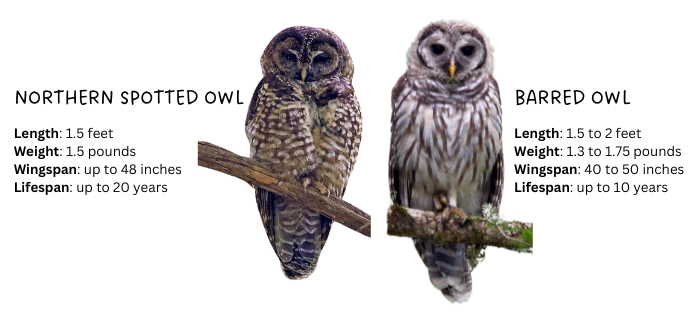In a bold and controversial move, the U.S. Fish and Wildlife Service proposes to kill over 500,000 barred owls in the Pacific Northwest over the next 30 years. This drastic measure aims to save the northern spotted owl, a species threatened with extinction and protected under the Endangered Species Act. The barred owls, native to the East Coast but now encroaching on the spotted owl’s territory, pose a significant threat due to their aggressive and territorial behavior.
The Rising Threat: Barred Owls’ Expansion
Since the 1950s, barred owls have expanded their range into the Northwest, thriving in environments where the spotted owl once dominated. They’re adaptable predators, consuming a wide variety of prey, which has led to their rapid population growth in the region. Their presence in Washington, Oregon, and Northern California now numbers over 100,000, significantly outnumbering the northern spotted owl.
The Rescue Plan: Targeted Culling
The proposed culling strategy involves using large-bore shotguns and night scopes to remove barred owls from key areas. This operation, unprecedented in scale, aims to reduce competition for resources and habitat, giving the northern spotted owl a fighting chance for survival. The plan also includes provisions for landowners to participate in the culling under strict guidelines and training.

Impact on Spotted Owl Populations
The decline of northern spotted owl populations is alarming, with decreases ranging from 35% to over 80% in the past two decades. Katherine Fitzgerald, the northern spotted owl recovery lead, emphasizes the severity of the situation, noting that barred owls are still invading and outcompeting spotted owls in their natural habitats.
Historical Efforts and Challenges
Efforts to save the northern spotted owl date back to the 1990s, with the implementation of the Northwest Forest Plan under the Clinton administration. This plan set aside millions of acres of old-growth forests, crucial for the owl’s survival. However, habitat loss due to logging and wildfires, combined with the barred owl invasion, has continued to threaten the species.
Expert Opinions: A No-Win Situation
Experts like Eric Forsman, a leading spotted owl researcher, view the culling program as a potentially endless and futile effort. Forsman, who has devoted his career to studying the spotted owl, fears that the species is on the brink of extinction regardless of the barred owl removal. This sentiment is echoed by other conservationists, who are grappling with the ethical and practical implications of such a large-scale cull.

A New Hope: Pilot Studies Show Promise
Pilot studies in Oregon, Washington, and northern California show encouraging results. Culling barred owls in these areas has led to stabilization in spotted owl populations, in contrast to continued declines in control areas. This success provides a glimmer of hope for the recovery of the northern spotted owl, but scaling up the program to a regional level remains a daunting challenge.
Public Perception and Ethical Considerations
The proposal has sparked intense debate among conservationists and the public. Bob Sallinger, executive director of Bird Conservation Oregon, highlights the moral dilemma posed by the culling program. While recognizing the need to prevent extinction, Sallinger and others are concerned about the broader ecological impacts and the precedent set by killing one protected species to save another.
The Strategy Has Worked Before: The Success Story of South Georgia Island

An example that mirrors the proposed strategy for the northern spotted owl is the eradication of invasive brown rats from South Georgia Island. This project aimed to protect native bird populations threatened by the non-native rats.
After years of effort, the initiative was successful, leading to a significant recovery in native bird species, including some critically endangered ones.
This precedent demonstrates that while controversial, such strategic species removal can indeed lead to positive outcomes for conservation efforts, offering hope for the spotted owl’s future.
As the public comment period opens, the fate of the northern spotted owl hangs in the balance. This situation underscores the complex and often painful choices involved in conservation efforts, especially when human activities have altered natural ecosystems to such a significant extent.















